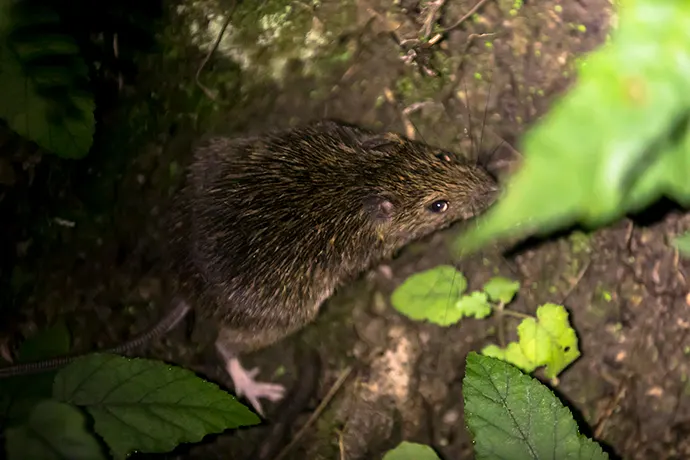
The Amami spiny rat, scientifically known as Tokudaia osimensis, is a small rodent species endemic to the Amami Islands of Japan. It belongs to the family Muridae and is closely related to other spiny rat species found in the region. Despite its small size and limited distribution, the Amami spiny rat has attracted attention due to its unique physical characteristics and ecological significance. In this article, we will shine the spotlight on the Amami spiny rat, exploring its habitat, behavior, and conservation status.
The Spiny Rat, also known as Tokunoshima Spiny Rat or Amamino Kuro-nezumi in Japanese, is a small rodent species that is native to the Amami Islands in Japan. These islands, located in the Ryukyu Archipelago, are known for their rich biodiversity and unique ecosystems. The Amami Spiny Rat, with its distinct spiky fur and small size, is one of the many fascinating creatures that call these islands home.
The habitat of the Amami Spiny Rat is primarily found in the dense forests and mountainous regions of the Amami Islands. These rats are well adapted to living in the undergrowth of the forests, where they can find shelter and protection from predators. The dense vegetation provides them with ample hiding places and a steady supply of food. They are also known to inhabit rocky areas and caves, where they can create burrows for nesting and breeding.
The distribution of the Amami Spiny Rat is limited to the Amami Islands, specifically Amami-Oshima, Tokunoshima, and Okinawa. These islands provide the ideal conditions for the survival of this species, with their subtropical climate and diverse range of plant species. The rats are most commonly found in the lowland forests, but they have also been spotted in higher elevations, up to 1,000 meters above sea level.
The Amami Spiny Rat is a nocturnal creature, meaning it is most active during the night. This behavior allows them to avoid predators and forage for food without much competition. They have a varied diet, consisting of fruits, seeds, insects, and small invertebrates. Their sharp teeth and strong jaws enable them to crack open nuts and seeds, while their agile bodies allow them to climb trees and navigate through the dense vegetation.
Despite their small size, the Amami Spiny Rat plays an important role in the ecosystem of the Amami Islands. They are considered seed dispersers, as they consume fruits and disperse the seeds through their droppings. This helps in the regeneration of the forests and contributes to the overall biodiversity of the islands. Additionally, they are prey for larger predators such as owls, snakes, and feral cats, making them an integral part of the food chain.
Unfortunately, the Amami Spiny Rat is currently facing threats to its habitat and population. Deforestation, primarily due to logging and agriculture, has resulted in the loss of their natural habitat. The introduction of invasive species, such as the mongoose, has also had a negative impact on their population. These factors, combined with their limited distribution, have led to the classification of the Amami Spiny Rat as a vulnerable species by the International Union for Conservation of Nature (IUCN).
Efforts are being made to protect the habitat of the Amami Spiny Rat and ensure its survival. Conservation organizations are working towards raising awareness about the importance of preserving the unique ecosystems of the Amami Islands. Measures such as reforestation, controlling invasive species, and establishing protected areas are being implemented to safeguard the future of this fascinating species.
In conclusion, the Spiny Rat is a small rodent species that is native to the Amami Islands in Japan. Its habitat primarily consists of dense forests and mountainous regions, where it can find shelter and food. The distribution of this species is limited to the Amami Islands, and it plays a crucial role in the ecosystem as a seed disperser. However, the Amami Spiny Rat is currently facing threats to its habitat and population, making conservation efforts essential for its survival.
In conclusion, shining the spotlight on the Spiny Rat is crucial for its conservation and protection. This unique and endangered species, found only on the Amami Islands of Japan, faces numerous threats including habitat loss and invasive predators. By raising awareness about its ecological importance and implementing effective conservation measures, we can ensure the survival of the Amami Spiny Rat and preserve the biodiversity of this region.
The Amami Spiny Rat (Tokudaia osimensis) is a species of rodent endemic to the Amami Islands of Japan. It is known for its distinctive spiky fur and small size, resembling a miniature hedgehog.
The Amami Spiny Rat is found exclusively on the Amami Islands, specifically on Amami Ōshima and Tokunoshima. These islands provide the ideal habitat of forests and dense vegetation where they can forage and nest.
The Amami Spiny Rat is characterized by its spiky fur, which serves as protection against predators, and its small size, typically measuring around 10-13 centimeters in length. It has a distinctive appearance compared to other rodent species.
As an endemic species, the Amami Spiny Rat plays a crucial role in the island ecosystems of Amami Ōshima and Tokunoshima. Its presence indicates the health of these ecosystems and highlights the importance of conservation efforts to protect their natural habitat.
Conservation efforts for the Spiny Rat focus on preserving its habitat through protected areas, monitoring populations, and raising awareness about the species’ importance. Efforts also include research to better understand its behavior and ecological needs.
Washoku, the term for traditional Japanese cuisine, represents a profound aspect of Japan’s rich cultural…
BVE Train Simulator, often simply known as BVE, is a highly realistic train simulation game…
The Queen's Pawn Game, classified under the code D00 in the Encyclopedia of Chess Openings…
Shinjuku, a bustling district in Tokyo, is renowned for its vibrant nightlife, skyscrapers, and extensive…
Ukai, or cormorant fishing, is a captivating and ancient Japanese tradition that dates back over…
Japanese fishing communities are redefining their economic future by tapping into the "sea industry," a…